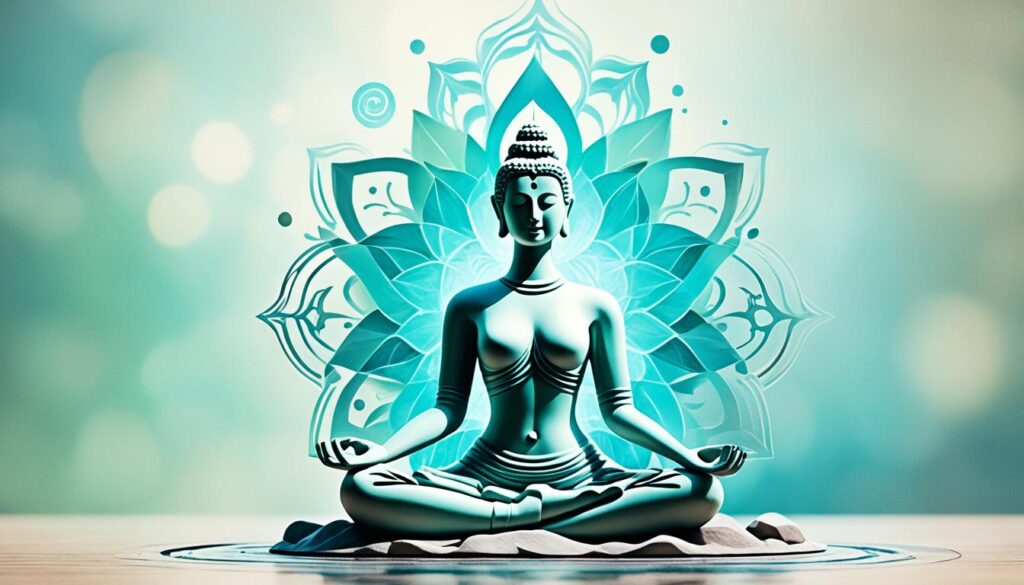Were you aware that more than 70% of adults say they feel stressed or overwhelmed every day? In today’s fast-moving and chaotic society, it’s crucial to prioritize inner peace and establishing a strong connection with ourselves.
The concept of stillness offers a path to tranquility and self-discovery. By embracing stillness, we have the opportunity to tap into our deepest inner self and find peace amidst the chaos. In this guide, we will explore the power of stillness and provide practical steps to help you cultivate inner peace in your life.
Key Takeaways:
- Stillness is an essential practice for finding inner peace in today’s fast-paced world.
- By embracing stillness, we can reduce stress, improve mental and physical health, and connect with our true selves.
- Incorporating stillness into our daily lives can help us maintain a sense of calm and presence.
- The breath plays a crucial role in accessing stillness and relaxation.
- Meditation, mindfulness, and movement practices can all contribute to cultivating stillness and inner peace.
Understanding the Importance of Stillness
In our fast-paced and chaotic lives, it’s easy to overlook the importance of stillness. Many of us perceive stillness as unproductive or a waste of time. However, embracing stillness is essential for our overall well-being and personal growth. It offers numerous benefits that contribute to our mental, emotional, and physical health.
By taking the time to be still, we give ourselves the opportunity to recharge and find clarity amidst the noise and busyness of everyday life. Stillness allows us to quiet our minds and create space for introspection and self-reflection. It is in these moments of stillness that we can truly connect with our inner selves, nurturing a deeper understanding of who we are and what we truly desire.
“In the midst of movement and chaos, keep stillness inside of you.”
― Deepak Chopra
The benefits of stillness extend beyond our mental and emotional well-being. When we cultivate stillness, we give our bodies the opportunity to relax and rejuvenate. It is during moments of stillness that our stress levels decrease, allowing our bodies to repair and replenish themselves.
Scientific research has also shown that stillness has a positive impact on our overall health. It has been linked to improved immune function, lower blood pressure, and better cognitive function. By regularly embracing stillness, we can enhance our physical health and increase our resilience to the challenges we face.
Through stillness, we also gain a greater sense of presence and mindfulness in our daily lives. By being fully present in the moment, we can engage more deeply with our surroundings and the people around us. Stillness helps us become more attuned to our thoughts, feelings, and actions, allowing us to make conscious choices that align with our values.
Whether it’s through practicing meditation, taking mindful walks in nature, or simply spending a few minutes in quiet contemplation, stillness can become a powerful tool in our personal growth and overall well-being. By making stillness a priority in our lives, we can experience greater peace, clarity, and fulfillment.
The Benefits of Stillness:
| Physical Benefits | Mental and Emotional Benefits | Spiritual Benefits |
|---|---|---|
| Reduces stress and anxiety | Enhances clarity and focus | Cultivates a deeper connection with oneself |
| Promotes relaxation and better sleep | Boosts creativity and problem-solving abilities | Fosters a greater sense of peace and inner calm |
| Improves immune function and overall health | Increases self-awareness and emotional intelligence | Deepens spiritual practice |
| Enhances cognitive function and memory | Reduces symptoms of depression and anxiety | Supports personal growth and transformation |
The Science behind Stillness
Research has shown that the science of stillness has profound effects on the brain and body. When we embrace a state of stillness, our brainwaves slow down, leading to relaxation, increased creativity, and improved focus. This allows us to tap into our inner wisdom and unlock our full potential.
In a world filled with constant stimulation and distractions, practicing stillness can have a transformative impact on our mental and physical well-being. Here are some of the effects of stillness on the brain and body:
- Reduced Stress: Stillness activates the body’s relaxation response, reducing the production of stress hormones like cortisol. This can help alleviate anxiety, lower blood pressure, and improve overall cardiovascular health.
- Improved Immune Function: Being still can boost our immune function by reducing inflammation in the body. This strengthens the immune system, making us more resilient to illnesses.
- Enhanced Cognitive Function: When we quiet our minds and enter a state of stillness, we create the ideal conditions for heightened cognitive function. This includes improved memory, enhanced problem-solving abilities, and increased mental clarity.
- Increased Emotional Well-being: Stillness allows us to cultivate a deep sense of inner peace and emotional balance. It helps regulate our emotions, reducing the frequency and intensity of negative feelings like anger, sadness, and anxiety.
- Improved Sleep: By practicing stillness before bed, we can promote better sleep quality. Stillness helps calm the mind and relax the body, enabling us to enter a state of deep rest.
The Effects of Stillness on the Brain
When we engage in stillness practices like meditation, the brain undergoes remarkable changes. Research has shown that meditation can:
- Increase Gray Matter: Regular practice of stillness has been linked to an increase in gray matter, particularly in regions associated with attention, self-awareness, and emotional regulation.
- Enhance Connectivity: Stillness can strengthen the connections between different regions of the brain, improving overall neural network function. This can lead to increased cognitive abilities and better information processing.
- Balance Brainwave Patterns: Different brainwave patterns are associated with different states of consciousness. Stillness helps balance these brainwave patterns, leading to a state of deep relaxation and clarity.
Understanding the science behind stillness can inspire us to incorporate it into our daily lives. By deliberately creating moments of stillness and making it a regular practice, we can harness its powerful effects on the brain and body.

| Effects of Stillness on the Brain and Body | Description |
|---|---|
| Reduced Stress | Activates the relaxation response, lowers stress hormones, and improves cardiovascular health |
| Improved Immune Function | Reduces inflammation, strengthens the immune system, and enhances resilience |
| Enhanced Cognitive Function | Improves memory, problem-solving abilities, and mental clarity |
| Increased Emotional Well-being | Regulates emotions, reduces negative feelings, and cultivates inner peace |
| Improved Sleep | Promotes better sleep quality by calming the mind and relaxing the body |
Techniques for Cultivating Stillness
When it comes to cultivating stillness, there are a variety of techniques and practices that can help us on our journey. These practices allow us to quiet the mind, release tension in the body, and enter a state of calm and tranquility. By exploring different techniques and finding what resonates with us, we can create a foundation for stillness in our lives.
1. Meditation

Meditation is a powerful tool for cultivating stillness. It involves focusing the mind and eliminating the constant chatter of thoughts. Through meditation, we can cultivate a calm and focused state of mind, leading us to a deeper sense of inner peace and tranquility. There are various meditation techniques to explore, such as mindfulness meditation, loving-kindness meditation, and visualization meditation. Each technique offers a unique pathway to stillness and self-discovery.
2. Deep Breathing
Deep breathing is a simple yet effective technique for cultivating stillness. By consciously focusing on our breath and taking deep, slow breaths, we can activate our body’s relaxation response and calm our nervous system. Deep breathing helps us release tension, reduce stress, and cultivate a sense of presence and stillness within ourselves. It can be practiced anywhere, at any time, making it a convenient technique to incorporate into our daily lives.
3. Mindfulness
Mindfulness is the practice of bringing our attention to the present moment with a sense of openness and non-judgment. By cultivating mindful awareness, we can quiet the mind’s constant chatter and become fully present in the here and now. Mindfulness can be practiced in various ways, such as mindful walking, eating, or even washing dishes. It allows us to cultivate stillness within our daily activities and brings a sense of peace and clarity to our lives.
4. Yoga
Yoga is a holistic practice that combines physical postures, breath control, and meditation. Through the practice of yoga, we can cultivate stillness by connecting our minds, bodies, and breath. The physical postures, or asanas, help release tension in the body and prepare us for seated meditation. The breath control, or pranayama, helps calm the mind and deepen our connection to the present moment. Yoga not only promotes physical health and flexibility, but it also offers a path to stillness and self-awareness.
“Cultivating stillness requires exploring different techniques and finding what resonates with us. Each individual is unique, and what works for one person may not work for another. By experimenting with different practices, we can discover the techniques that bring us closer to a state of calm and tranquility.
5. Additional Techniques
In addition to meditation, deep breathing, mindfulness, and yoga, there are many other techniques and practices that can support us in cultivating stillness. These include:
- Progressive muscle relaxation
- Guided imagery
- Aromatherapy
- Journaling
- Awareness of the senses
Each of these techniques offers a unique approach to cultivating stillness and can be explored based on personal preferences and interests.
Remember, cultivating stillness is a personal journey, and it may take time to find the techniques that resonate with you. Be patient with yourself and enjoy the process of exploring different practices. Through consistent effort and an open mind, you can create a foundation for stillness in your life and experience the transformative power it brings.
Integrating Stillness into Daily Life
Stillness is not only meant for moments of solitude but can also be seamlessly integrated into our daily lives. By consciously incorporating stillness, we can create small pockets of calm and serenity amidst the busyness of our routines. Here are some practical ways to infuse stillness into your daily life:
Meditation Breaks
Take short meditation breaks throughout the day to pause, reset, and reconnect with your inner self. Find a quiet space, sit comfortably, close your eyes, and focus on your breath. Allow yourself to be fully present in the moment, embracing the stillness within.
Mindful Eating
Transform mealtime into a mindful experience by savoring each bite and fully engaging your senses. Pay attention to the flavors, textures, and aromas of your food. Chew slowly, appreciating the nourishment it provides. This practice cultivates mindfulness and invites stillness into your daily routine.
Connect with Nature
Step outside and immerse yourself in the beauty of nature. Take a walk in the park, sit by a lake, or hike through a forest. Engaging with the natural world can help you quiet your mind, find peace, and reconnect with the present moment.
Breathe in the stillness of nature and let it nourish your soul.
Embrace small moments of stillness throughout your day, inviting a sense of calm and presence into every activity you undertake.
| Benefits of Integrating Stillness into Daily Life | Ways to Incorporate Stillness |
|---|---|
| Reduces stress and anxiety | Take meditation breaks |
| Improves mental clarity and focus | Practice mindful eating |
| Promotes overall well-being | Connect with nature |
By consciously integrating stillness into your daily routine, you can experience the transformative power of inner peace, leading to greater clarity, harmony, and contentment in your life.

The Power of Breath in Stillness
In the quest for stillness, one of the most powerful tools we can harness is the breath. Our breath is a constant companion, a bridge between our inner world and the external environment. By consciously attuning to our breath, we can tap into its transformative power and deepen our connection to stillness.
The practice of breathwork, also known as conscious breathing, is a gateway to profound states of calm and presence. It allows us to anchor ourselves in the present moment, quiet the mind, and attain a deep sense of relaxation. By directing our attention to the rhythm and depth of our breath, we cultivate a harmonious connection between our body and mind.
One breathwork technique that can facilitate stillness is deep belly breathing. This technique involves taking slow, deep breaths, allowing the belly to rise and fall with each inhale and exhale. Deep belly breathing stimulates the parasympathetic nervous system, promoting a state of relaxation and calmness. It can be practiced both in stillness and during daily activities, serving as a gentle reminder to anchor ourselves in the present moment.
The power of breath lies in its ability to guide us to a place of stillness within ourselves. As we consciously regulate our breath, we create space for quiet reflection, inner peace, and profound self-awareness.
Another powerful breathwork technique is alternate nostril breathing, also known as Nadi Shodhana. This technique involves using the fingers to alternate between closing one nostril and breathing in and out through the other nostril. Alternate nostril breathing helps balance the energy in the body, harmonize the left and right hemispheres of the brain, and quiet the chatter of the mind. It can be particularly beneficial for those seeking mental clarity and a deeper connection to stillness.

| Benefits of Breathwork for Stillness | Techniques |
|---|---|
| 1. Calms the mind and reduces stress | – Deep belly breathing |
| 2. Increases present moment awareness | – Alternate nostril breathing |
| 3. Facilitates relaxation and emotional well-being | – Ocean breath |
| 4. Enhances focus and concentration | – Box breathing |
Breathwork offers a practical and accessible path to unlock the power of stillness. By incorporating breathwork techniques such as deep belly breathing and alternate nostril breathing into our daily lives, we can cultivate a deeper sense of calm, emotional well-being, and self-awareness. Let the power of breath guide you on your journey to stillness.
Exploring Different Meditation Practices
Meditation is a powerful tool for cultivating stillness. Through various meditation practices, we can quiet the mind, cultivate self-awareness, and connect with our inner essence. Let’s explore some of the different techniques and types of meditation that can lead us to a state of deep stillness.
Mindfulness Meditation
One popular form of meditation is mindfulness meditation. In this practice, we focus our attention on the present moment, observing our thoughts, emotions, and sensations without judgment. By anchoring our awareness in the present, mindfulness meditation helps us cultivate a sense of stillness and peace.

Loving-Kindness Meditation
Loving-kindness meditation, also known as metta meditation, involves the cultivation of love, compassion, and kindness towards ourselves and others. By directing our attention to positive intentions and well-wishes, this practice promotes deep emotional stillness and fosters a sense of connection and empathy.
Visualization Meditation
In visualization meditation, we use our imagination to create vivid mental images, often guided by audio recordings or scripts. By visualizing peaceful and serene scenes or engaging in future-oriented visualizations, we can create a sense of tranquility and stillness within the mind and body.
Mantra Meditation
In mantra meditation, we repeat a specific word, phrase, or sound, known as a mantra, to focus our attention and quiet the mind. The repetitive nature of mantra meditation helps us enter a state of deep stillness and concentration, allowing us to transcend ordinary thoughts and experience a sense of pure awareness.
Transcendental Meditation
Transcendental Meditation (TM) is a technique that originated from Vedic traditions. During TM, practitioners silently repeat a specific mantra to access a transcendent state of consciousness. This practice helps us go beyond the surface level of the mind and experience a profound sense of stillness and inner peace.
Walking Meditation
For those who prefer a more active form of meditation, walking meditation offers a pathway to stillness. In walking meditation, we bring our attention to the physical sensations of each step, focusing on the movement of the body and the rhythm of the breath. This practice allows us to find stillness in motion and cultivate a sense of presence and centeredness.
Body Scan Meditation
Body scan meditation involves systematically directing our attention through different parts of the body, bringing awareness to physical sensations and releasing tension. By scanning our body with mindfulness, we cultivate a sense of stillness within ourselves and develop a deep connection between the mind and body.
Types of Meditation
| Type of Meditation | Description |
|---|---|
| Mindfulness Meditation | Focuses on observing the present moment without judgment. |
| Loving-Kindness Meditation | Cultivates love, compassion, and kindness towards oneself and others. |
| Visualization Meditation | Uses visualization techniques to create a sense of tranquility and peace. |
| Mantra Meditation | Involves repeating a specific word or sound to quiet the mind. |
| Transcendental Meditation | Accesses a transcendent state of consciousness through the repetition of a mantra. |
| Walking Meditation | Brings mindfulness to the physical sensations of walking. |
| Body Scan Meditation | Directs attention to physical sensations in different parts of the body. |
These are just a few examples of the many meditation practices available to us. Each practice offers a unique pathway to stillness and can be explored to find the ones that resonate most with our individual preferences and needs.
By incorporating different meditation practices into our lives, we can deepen our experience of stillness, cultivate inner peace, and enhance our overall well-being.
Finding Stillness in Movement
In our journey to cultivate stillness, it’s important to recognize that stillness doesn’t always mean being physically still. There is a beautiful paradox in finding stillness through movement, where the body becomes a conduit for inner peace and presence. Practices like yoga, tai chi, and qigong offer a pathway to experiencing stillness within the flow of movement. These moving meditations allow us to bring our awareness to the present moment, synchronize our breath with each movement, and connect deeply with our bodies.
Through these practices, we enter a state of flow, where our minds quiet down and our bodies find a harmonious rhythm. The dance between stillness and movement becomes a moving meditation, a sacred union of body, mind, and spirit.
Yoga, with its graceful postures and deliberate breathwork, invites us to explore the depths of stillness in every movement. As we flow through sequences, we cultivate a sense of mindfulness, grounding ourselves in the present moment and deeply connecting with each breath. Yoga teaches us to find stability, balance, and peace, both on and off the mat.
Tai chi, a martial art rooted in Chinese philosophy, combines slow and deliberate movements with deep breathing. It is often referred to as “meditation in motion” and focuses on cultivating a sense of internal energy, vitality, and stillness. Through the precise and flowing movements of tai chi, we find a sense of calm and profound relaxation.
Qigong, another ancient Chinese practice, involves gentle movements, breathwork, and visualization to harmonize the flow of energy within the body. Qigong emphasizes the cultivation of “qi,” the life force energy, and helps us access a deep state of tranquility and stillness. The slow, deliberate movements create a sense of mindfulness and presence that allows us to connect with our body’s innate wisdom.
“Movement is the song of the body, while stillness is the song of the soul.” – Gabrielle Roth
Incorporating these practices into our lives offers not only a physical workout but also a profound opportunity for self-discovery and inner peace. The combination of movement and stillness allows us to access a state of flow, where we are fully present in the moment, surrendering to the wisdom of our bodies and finding peace in the rhythm of our breath.

Cultivating Stillness in Everyday Life
Stillness has the power to transform not only our quiet moments of solitude but also our everyday lives. By integrating stillness into various aspects of our day, we can bring a sense of presence, calm, and mindfulness to our activities and interactions.
Mindful Eating
One way to cultivate stillness in everyday life is through mindful eating. Instead of rushing through meals or eating on the go, we can take the time to savor each bite, paying attention to the flavors, textures, and sensations. By slowing down and fully engaging with our meal, we not only nourish our bodies but also cultivate a deeper connection with our food and the present moment.
Mindful Communication
Mindful communication allows us to bring stillness into our interactions with others. By actively listening and being fully present in conversations, we can deepen our connections and foster genuine understanding. Practicing empathy and non-judgment in our communication creates a space for stillness to emerge, fostering meaningful connections and promoting a harmonious environment.
“The most precious gift we can offer anyone is our attention.”
Mindful Movement
Engaging in mindful movement practices, such as yoga, walking, or simple stretching, can also help us cultivate stillness in our daily lives. By bringing our attention to the present moment and focusing on the sensations of our bodies, we can enter a state of flow and tranquility. Through mindful movement, we can find stillness amidst physical activity, enhancing our well-being and promoting a sense of balance.

By incorporating stillness and mindfulness into our everyday activities, we can navigate life’s challenges with greater ease and create a deeper sense of fulfillment. Whether it’s savoring our meals, practicing mindful communication, or engaging in mindful movement, stillness can become an integral part of our daily routines, helping us find peace and calm in the midst of busyness.
Exploring Stillness in Ancient Wisdom Traditions
Throughout history, various spiritual and wisdom traditions have emphasized the importance of stillness. Whether it’s Buddhism, Hinduism, Taoism, or Indigenous wisdom, these traditions offer profound insights into the power of stillness. By exploring their teachings, we can gain wisdom and inspiration to deepen our own practice of stillness.

Ancient wisdom traditions have long recognized the transformative and healing qualities of stillness. They have understood that within the deep silence lies the essence of existence. By quieting the mind and body, we can access the timeless wisdom that dwells within us.
“Stillness is not the absence of movement or noise; it is the state of inner calmness and tranquility.”
– Ancient Wisdom Saying
In Buddhism, the practice of meditation is central to attaining stillness. By meditating, one can cultivate mindfulness, serenity, and inner peace. The teachings of the Buddha guide practitioners to let go of attachments to thoughts, desires, and external distractions, allowing for a deep connection with the present moment.
In Hinduism, stillness is often associated with the concept of “Samadhi” or the state of complete absorption. Through yoga, meditation, and self-discipline, individuals can transcend the limitations of the ego and merge with the divine essence of the universe.
Taoism teaches that stillness is the foundation of all life. The Tao, often symbolized by the yin-yang, encompasses both stillness and movement. By aligning with the flow of nature and embracing the rhythm of stillness, individuals can cultivate balance and harmony in their lives.
Indigenous wisdom traditions across the world have also emphasized the significance of stillness. In Native American cultures, vision quests and solitary retreats in nature are practices that allow individuals to connect deeply with the earth, their ancestors, and the spiritual realms.
The Wisdom of Stillness in Ancient Traditions
| Tradition | Key Teachings |
|---|---|
| Buddhism | Meditation as a path to stillness and mindfulness. |
| Hinduism | The pursuit of Samadhi and union with the divine. |
| Taoism | Harmony and balance through alignment with the Tao. |
| Indigenous Wisdom | Connecting with nature and ancestral wisdom. |
Exploring the teachings of ancient wisdom traditions can inspire and deepen our own practice of stillness. The wisdom passed down through generations reminds us of the transformative power of quieting the mind, connecting with our inner selves, and aligning with the greater harmony of the universe.
Embracing Stillness as a Lifelong Journey
Stillness is not a destination but a lifelong journey. It is a continuous process that requires patience, commitment, and self-compassion. As we embark on this path, we open ourselves up to personal growth, heightened self-awareness, and a deepening connection with our truest selves.
When we embrace stillness as a lifelong journey, we recognize that it is not something to be achieved or checked off a list. Instead, it becomes an integral part of our daily lives, guiding us through the ups and downs, the joys and challenges. It becomes a way of being, a state of mind and heart that permeates every aspect of our existence.
Through the lifelong journey of stillness, we learn to navigate life’s uncertainties and complexities with greater ease and grace. As we cultivate the art of stillness, we gain a profound sense of inner peace and resilience that sustains us through life’s storms. We discover the power of presence, the ability to fully engage in the present moment and let go of distractions and worries.
In this lifelong journey, we also uncover our deepest truths and values. As we quiet the noise of the outside world and turn inward, we gain clarity about what truly matters to us. We become aware of our passions, dreams, and aspirations, and we develop the courage to live in alignment with our authentic selves.
Embracing stillness as a lifelong journey is not always easy. It requires consistent practice, dedication, and a willingness to confront our fears and shadows. But, in this process, we experience a profound transformation and find freedom and fulfillment that can only come from within.
The lifelong journey of stillness is not a solitary one. We are not alone on this path, for there are countless others who walk alongside us, seeking the same sense of inner peace and personal growth. Together, we can support and inspire one another, sharing our experiences, insights, and challenges. We can create communities of stillness that nurture and uplift us on this transformative journey.
The Benefits of Embracing Stillness as a Lifelong Journey:
- Cultivating personal growth and self-awareness
- Finding inner peace and tranquility
- Developing resilience in the face of challenges
- Gaining clarity about our values and purpose
- Living in alignment with our true selves
- Building a supportive community of fellow seekers
The lifelong journey of stillness is a gift we give ourselves. It is an ongoing exploration of our inner landscape, a deepening connection with our essence, and a way of living that brings joy, fulfillment, and freedom. Let us embrace this journey wholeheartedly, knowing that the rewards are immeasurable.

Conclusion
Embracing stillness offers a profound path to inner peace and self-discovery. By exploring different techniques, understanding the science behind stillness, and integrating stillness into our daily lives, we can cultivate a deep sense of calm, clarity, and resilience.
Stillness is not a destination but a lifelong journey. It requires commitment and dedication, but the rewards are transformative. As we embark on this journey, let us remember that stillness is a personal experience, unique to each individual. Allow yourself the time and space to explore what brings you inner peace and embrace the practices that resonate with you.
Through the practice of stillness, we can find solace in the present moment and connect with our truest selves. It is in this state of calm and clarity that we can navigate life’s challenges with grace and find deep fulfillment along the way.
May your journey towards stillness be filled with peace, joy, and a profound sense of inner connection. Embrace the power of stillness and discover the transformative potential that lies within you.
How Can Being in Stillness Help in Exploring Inner Peace?
In the hectic pace of modern life, it’s easy to feel overwhelmed. However, taking the time to find clarity in stillness can be a powerful way to explore inner peace. By quieting the mind and being present in the moment, individuals can gain a deeper understanding of themselves and find a sense of tranquility.
FAQ
What is stillness?
Stillness refers to a state of calm and tranquility, where the mind and body are at rest. It is a pause in the busy and chaotic nature of life, allowing for inner peace and self-discovery.
Why is stillness important?
Stillness is important for our overall well-being. It allows us to recharge, find clarity, and cultivate resilience. By taking the time to be still, we can reduce stress and anxiety, improve our mental and physical health, and connect with our true selves.
What are the benefits of stillness?
Stillness has numerous benefits on the brain and body. It slows down brainwaves, leading to relaxation, increased creativity, and improved focus. It also reduces stress, improves immune function, and promotes better cognitive function.
How can I cultivate stillness?
There are various techniques and practices that can help cultivate stillness, such as meditation, deep breathing, mindfulness, and yoga. By exploring these practices and finding what resonates with you, you can create a foundation for stillness in your life.
Can I incorporate stillness into my daily life?
Absolutely! Stillness can be integrated into daily life through small pockets of stillness, such as short meditation breaks, mindful eating, or connecting with nature. By consciously incorporating stillness into your routines, you can maintain a sense of calm and presence amidst the busyness of life.
How does breathwork relate to stillness?
The breath plays a crucial role in accessing stillness. By focusing on the breath, you can anchor yourself in the present moment, calm your mind, and enter a state of relaxation. Various breathwork techniques, such as deep belly breathing and alternate nostril breathing, can help deepen your connection to stillness.
What are some meditation practices for cultivating stillness?
There are various meditation practices to explore, including mindfulness meditation, loving-kindness meditation, and visualization meditation. Each practice offers a unique pathway to stillness, allowing you to quiet the mind, cultivate self-awareness, and connect with your inner essence.
Can stillness be found in movement?
Yes, stillness can be found in movement through practices like yoga, tai chi, and qigong. These practices allow you to bring awareness to your body, synchronize your breath with movement, and enter a state of flow. Moving meditations help cultivate stillness while promoting physical health and vitality.
How can stillness be incorporated into everyday life?
Stillness can be incorporated into various aspects of daily life, such as mindful eating and mindful communication. By slowing down and fully engaging in the present moment, you can cultivate a deeper connection with yourself and the world around you.
What can ancient wisdom traditions teach us about stillness?
Ancient wisdom traditions like Buddhism, Hinduism, Taoism, and Indigenous wisdom emphasize the importance of stillness. Exploring their teachings can provide profound insights into the power of stillness, offering wisdom and inspiration to deepen your own practice.
Is stillness a lifelong journey?
Yes, stillness is not a destination but a lifelong journey. It requires patience, commitment, and self-compassion. As you continue to cultivate stillness in your life, you can experience personal growth, heightened self-awareness, and a deeper connection with your truest self.









